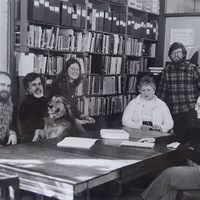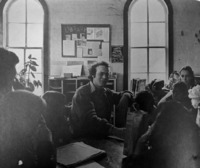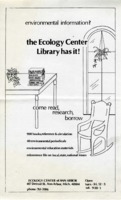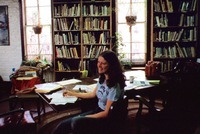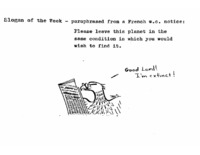Becoming a Community Resource
After opening in May 1970, the Ecology Center began working in the Ann Arbor community on developing not only ambitious, large-scale community projects, like the recycling station and the organic garden, but also the small-scale, daily services to be offered at the Center. These continuing services, including the library, the bookstore, the newsletter, and the switchboard helped the Ecology Center teach the public about the many environmental issues that affected their lives and to establish its identity as a trusted resource for environmental information in the process.
Library and Bookstore
On the second floor of the 417 Detroit Street building, the Ecology Center started a lending library to provide extensive information resources on environmental topics, such as organic gardening, energy conservation, and local, state, and national ecological issues. The library contained books, magazines, newsletters, reference books, teaching materials, and a public filing system, including pamphlets, research papers, and articles. Any Washtenaw County resident could check out books, periodicals, and more for two weeks at a time.
The librarian, resources manager, and education coordinator worked tirelessly to organize and expand the library and its programs. In January 1974, the Ecology Center announced the reopening of its newly decorated, reorganized, and expanded library, which included a new section of children’s books and many new books on a range of topics, including energy, consumer action, food, and recreation. Two years later, the library made another leap and joined the Ann Arbor Public Library’s extension service program, which enabled the Ecology Center to order a variety of new books from the extension service’s collection of 25,000 volumes. This partnership also led to the debut of a ‘story-time’ program with the ‘storyladies’ from the Public Library Outreach Department that drew many young children and families to the Center. With the donation of books, money, and time from the Public Library, publishing companies, individual donors, and Ecology Center members, the library improved its resources and housed over 1000 books by 1979.
For visitors who wanted to purchase books rather than renting them from the library, the Ecology Center also operated a bookstore on the ground floor of the Ecology Center building. Also available were ecology buttons and notebook paper made from recycled waste.
Newsletter
Though the title, format, and content changed over the course of the 1970s, the newsletter remained a crucial service for the dissemination of information on local, state, and national issues, as well as for the operational needs of the Center. Though the goal of the newsletters was to inform, the editors ensured that the newsletters did so in an entertaining fashion. Including humorous images, poetry, and book and movie recommendations, the newsletter depicted the personality of the Ecology Center and demonstrated the joys of the ecological lifestyle for which they advocated. Through the newsletters, the Ecology Center established its institutional identity and its position in the Ann Arbor community while keeping the readership informed and engaged.
The first newsletter issues ran with the Ecology Center name on the cover, but the Center’s tax-exempt status as an educational, non-profit, non-lobbying organization limited the content they could cover. In the August 1970 newsletter, the Center staff announced that “rather than change the content of the newsletter and hobble your editors’ freedom to editorialize and give support to legislative action,” they would “sever the newsletter’s monetary ties with the Ecology Center” and take the name “ENACT Ecology Reports.” In excess of printing and distribution costs, any income from the newsletter went to the Ecology Center and ENACT. The newsletter later took the original name again in the early months of 1973 when the student group dissolved.
Since its first publication, the Center continually experimented with printing to use less paper, pay a lower cost, and look more professional, but the general layout and appearance remained consistent despite editor and content changes. The early newsletters covered a broad array of topics from global and national issues, such as the air pollution crisis and the Alaska pipeline controversy, to local and even neighborhood issues, such as bus routes and bicycle paths. Throughout the decade, the content leaned further and further towards the latter, focusing on bettering the Ann Arbor community by offering practical advice for readers to put into action in their neighborhoods and homes and publicizing Center community events. In so doing, the newsletter equipped readers to make meaningful contributions to better the environment and the quality of life in Ann Arbor.
Switchboard
To routinely answer telephone inquiries about Center activities, the Ecology Center began offering a switchboard service in 1970. The role of the service soon expanded as dozens of calls poured in each day with questions about many areas of environmental concern, including “how to dispose to 100,000 gallons of contaminated gasoline and how to find untreated seeds for an organic garden.” The Ecology Center trained volunteers to respond to questions about local activities and, if the questions were too technical for a simple response, to redirect callers to local experts who volunteered their time and knowledge to the public. By 1971, with an average of 75 calls per day, this useful resource had become the most frequently used Ecology Center service for keeping the community informed.

